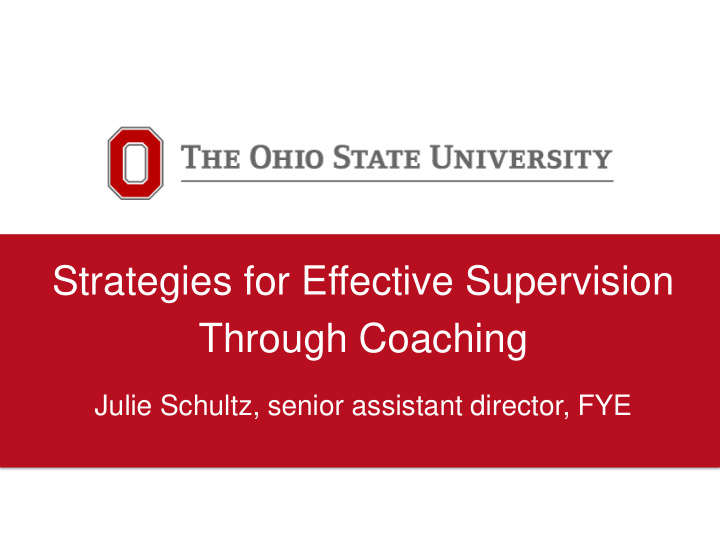



Strategies for Effective Supervision Through Coaching Julie Schultz, senior assistant director, FYE
Presentation Overview • Why coaching? • Activities • Your best coach • Coaching self-assessment • Skills of Coaching • Setting expectations • Listening • Giving Feedback • Q&A 2
ACPA/NASPA Professional Competencies Human and Organizational Resources • Conflict Management • Team-building • Motivation • Supervision • Hiring http://www.naspa.org/images/uploads/main/Professional_Competencies.pdf 3
CAS Standards Organization and Leadership • Manage human resource processes including recruitment, selection, development, supervision, performance planning, evaluation, recognition, and reward. • Empower professional, support, and student staff to accept leadership opportunities. • Offer appropriate feedback to colleagues and students on skills needed to become more effective leaders. • Encourage and support professional development, collaboration with colleagues and departments across the institution, and scholarly contribution to the profession. http://www.cas.edu/index.php/cas-general-standards/ 4
Coaching Research • There are many different types of staff development programs that can be utilized by managers including workshops, newsletters, flexibility to take academic coursework, temporary staff assignments, interdepartmental staff exchanges, mentoring, and coaching (Komives et al, 2003) • According to Goldsmith and Lyon (2006) coaching “helps people become more than they realize they can be” and can “unlock the latent leadership potential and reinforce leadership where it already exists.” • When productively applied to a supervision relationship, “coaching helps the client identify what is important and how to use their skills to foster it.” (International Institute of Coaching) 5
Definitions Managing: The planning and control of the work process. Developing goals, plans, steps, time, monitoring progress. 6
Definitions Supervising: The direction of people at work. Focused on skill building and knowledge transfer. 7
Definitions Mentoring: Relationship oriented, long term, often outside reporting lines, provide direction. 8
Definitions Coaching: Working with individuals to help them reach their own conclusions and solutions. Focused on self-defined goals, working from strengths, and on the staff person as a learner. 9
10
11
Three factors lead to higher employee engagement and satisfaction: Autonomy Mastery Purpose 12
13
Your Best Coach Think about a person in your life who was a good coach. • What were the characteristics of that person? • How did they make you feel? • What did they do to help you learn and grow? • What did this person do to inspire you? 14
Coaching Self Assessment 15
16
Coaching Skill Sets Setting Expectations Listening Giving Feedback 17
18
19
20
Ideas for Low Cost or No Cost Recognition 1. Allow your employees to work at home for a day 2. Volunteer to do your employees least favorite task for a week 3. Let your employee dress casual for a day 4. Write a formal note or letter of praise and copy your organization’s leadership 5. Give your employee their choice of the next project, committee, or task on which to work. 21
Application of Coaching Skills 22
Conversations Setting Expectations: Think of an employee you are currently coaching. What is your relationship like? What does s/he need from you as a coach? What could you do differently? What is an immediate change you can make? Listening: What are some powerful questions you can see yourself using with an employee? How do you think this would change your relationship? Giving Feedback: Plan a feedback conversation you need to have. What does that conversation include? What have you learned that you can apply? 23
Handouts available at http://u.osu.edu/schultz.173/2014/02/07/ fyeconferencematerials/ 24
Questions? Julie Schultz, schultz.173@osu.edu 25
Recommend
More recommend